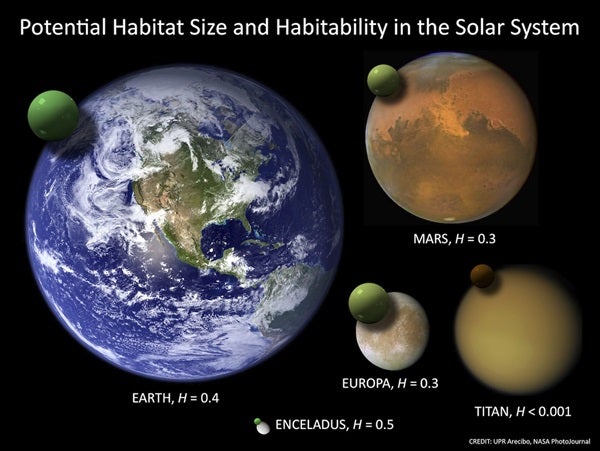A new study by the University of Puerto Rico at Arecibo shows the first quantitative evaluation of planetary habitability. The study identifies some potential habitats in the solar system and also shows how the habitability of our planet has changed in the past, with some periods being even better than today.
Professor Abel Mendez presented his results Monday, October 5, at the 41st Annual Meeting of the Division for Planetary Sciences of the American Astronomical Society in Fajardo, Puerto Rico.
Editor’s note: Read Astronomy magazine Associate Editor Liz Kruesi’s reports from DPS09.
The study of planetary habitability has become more important with climate change as has the search for habitable environments in the solar system and beyond. Many environmental factors control the habitability of a planet in complex ways, but a direct assessment of the habitability of a planet has been a continuous problem in planetary sciences.
“It is surprising that there is no agreement on a quantitative definition of habitability,” said Mendez, a biophysicist from the university’s Department of Physics and Chemistry. “There are well-established measures of habitability in ecology since the 1970s, but only a few recent studies have proposed better alternatives for the astrobiology field, which is more oriented to microbial life. However, none of the existing alternatives from the fields of ecology to astrobiology has demonstrated a practical approach at planetary scales.”
Mendez’s approach to the study of planetary habitability started with the development of a Quantitative Habitability Theory (QH Theory) to assess the current state of terrestrial habitability and to establish a baseline for relevant comparisons with past or future climate scenarios and other planetary bodies including extrasolar planets.
“QH Theory is based on two new biophysical parameters: the habitability H, as a relative measure of the potential for life of an environment, or habitat quality, and the habitation M, as a relative measure of biodensity, or occupancy,” Mendez said. “Both parameters are related to other physiological and environmental variables and can be used to make predictions about the distribution, abundance, and productivity of primary producers, such as plants and phytoplankton, and microbial life in general. Initially, habitability was modeled from the environment’s temperature and humidity because they are easier to measure at planetary scales with ground or orbital instruments. Global habitability and habitations maps were constructed of terrestrial land and ocean areas with data gridded at various spatial and temporal resolutions. Preliminary work shows that the QH Theory is comparable to existing models in predicting terrestrial primary productivity.”
“This work is important because it provides a quantitative measure for comparing habitability,” said Chris McKay of NASA Ames Research Center in California. “It provides an objective way to compare different climate and planetary systems.”
Studies about the effects of climate change on life are of special interest to the scientific community and to the general public. One of the goals of Mendez’s studies is to trace the evolution of terrestrial habitability from paleoclimates to global warming.
“The biophysical quantity Standard Primary Habitability (SPH) was defined as a base for comparison of the global surface habitability for primary producers,” Mendez said. “The SPH is always an upper limit for the habitability of a planet but other factors can contribute to lower its value. The current SPH of our planet is close to 0.7, but it has been up to 0.9 during various paleoclimates, such as during the late Cretaceous period when the dinosaurs went extinct. I’m now working on how the SPH could change under global warming.”
“This methodology could also be extended to studies of planets around other stars that may be found during the next two decades,” said geoscientist James Kasting at Penn State University.
The search for habitable environments in the universe is one of the priorities of the NASA Astrobiology Institute and other international organizations. Mendez’s studies also focus on the search for life in the solar system, as well as extrasolar planets.
“Various planetary models were used to calculate and compare the habitability of Mars, Venus, Europa, Titan, and Enceladus,” Mendez said. “Interestingly, Enceladus resulted as the object with the highest subsurface habitability in the solar system, but too deep for direct exploration. Mars and Europa resulted as the best compromise between habitability and accessibility. In addition, it is also possible to evaluate the global habitability of any detected terrestrial-sized extrasolar planet in the future. Further studies will expand the habitability definition to include other environmental variables such as light, carbon dioxide, oxygen, and nutrients concentrations. This will help expand the models, especially at local scales, and thus improve its application in assessing habitable zones on Earth and beyond.”
“I was pleased to see Enceladus come out the winner,” McKay stated. “I’ve thought for some time that it was the most interesting world for astrobiology in the solar system.”










